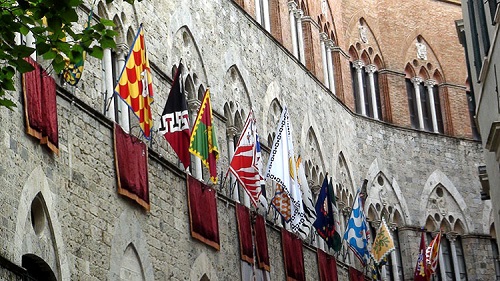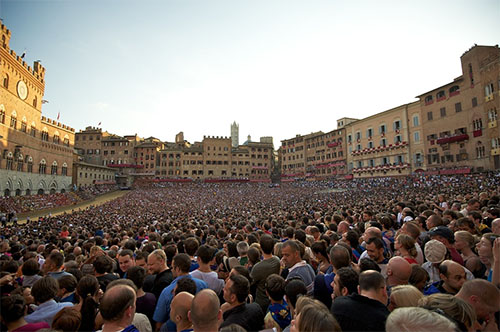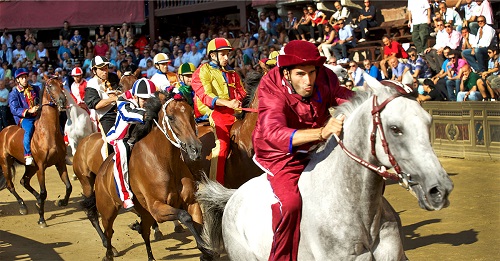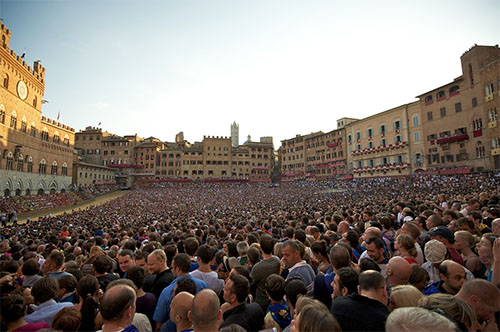The World’s Best Horse Race
No one knows for sure when it began or exactly why, but official record formalizes the event starting in 1310. By that time, it was already an institution.
I’ve wanted to witness this spectacle firsthand since I learned of it more than 30 years ago. The Palio of the Contrade, the raw, primitive, visceral horse race with murky origins wrapped in myth that takes place twice every summer in Siena, Italy, captured my imagination from an early age. This is passion, intensity, and intrigue incarnate.
Each July 2 and then again on August 16, mercenary jockeys pound bareback three times around the dirt track of Siena’s Piazza del Campo before a crowd of 60,000 patriots and pilgrims. Each jockey, chosen by each contrada according to an ancient anything-goes system of bribery and backdoor deals agreed with handshakes, is handed a nerbo, a whip made of ox sinew, as he enters the track, with which he is free… indeed, encouraged… to beat and block the other jockeys and their horses.The order of riders, like many things about this race, is determined according to clandestine deals and plain envelopes delivered by secret messengers. During the days leading up to the Palio, Siena’s labyrinth alleyways are the scene of legendary chicanery and conspiracy.

Each horse and rider represent one of Siena’s contrade. At one time, this city included more than 80 of these communes, or neighborhoods. After the Black Death, many contrade disappeared altogether. Then, over the centuries, others were combined. Since 1729, Siena has been comprised of 17 contrade, a number now set in stone.
Ten contrade, chosen by lots, compete in the July 2 race; the other seven run in August. In fact, it’s the contrada’s horse… or, more precisely, the contrada’s colors, which each horse displays at its mane… that wins the race. The jockey, though the focus of much attention, is incidental.
A jockey can fall off his horse and that horse can still carry the day. This is not wholly uncommon. Remember, these guys are racing around a narrow dirt track on the sweaty backs of unsaddled horses while all trying to poke, kick, and otherwise interfere with the progress of all their fellows and being poked, kicked, and otherwise interfered with themselves. It’s a wild free-for-all that lasts all of 90 seconds and almost always includes mishap and injury.
Last Sunday we watched as one rider tumbled from his horse, was trampled by two others, and then stood up to be surrounded in an instant by the emergency medical team standing by in case of just such an incident. Holding a backboard against the rider’s side they hustled him off the dirt and through one of the narrow hidden stone archways that provide access in and out of the piazza. In a flash he was gone, but his horse sped onward.
The other reason it’s common for riders to lose their seats is that this is no ordinary race track. The Piazza del Campo is not square or rectangular but shell-shaped, meaning a very irregular route around. Making things more interesting still, the square is positioned at the intersection of Siena’s three hills and slopes at the center. The two resulting dips, which sit at sharp turns, are ridiculously dangerous when traversed at great speed bareback with a bunch of guys flailing whips at you. The falls can be spectacular.
The Piazza del Campo is not ordinarily covered with dirt. Clay and sand are shoveled on to the stone days before the race, in precise amounts, to create a safe base. The surrounding restaurants must close so that bleacher seats can be set up all around the route. We sat just two rows above the dirt.

For the Sienese, the Palio is not a horse race and not a centuries-old tradition. For the Sienese, the Palio is the meaning of life. A Sienese saying goes something like, “You are born… you witness the Palio… then you die.”
This is not about money. Every contrada has expenses (all those bribes add up, plus each jockey is paid handsomely for the risks he takes), and the winning contrada makes a donation to a selected charity.
In return, the winning contrada is rewarded with the drappellone, a hand-painted banner created specifically for each race, two per year. For the Sienese, the bragging rights that come with the drappellone are worth more than any purse.
The evening before the race, each contrada hosts a dinner. Historically private, today, keen to earn money to cover costs any way they can, each contrada sells tickets to these receptions, meaning we tourists can witness the speeches, the blessings, and the other goings-on. I wondered if the Sienese seated alongside us minded that we and more than a thousand others from countries that did not exist when the first Palios were run and with no authentic understanding of the significance of the events in play had crashed their party.
Our Palio package affiliated us with the Tartuca (turtle) contrada, from the oldest part of the city. The jockey for the Tartuca contrada this July was Luigi Bruschelli, known as Gigi and one of the most famous and successful jockeys in Palio history with 13 wins between 1996 and 2012. Gigi was the favorite for last Sunday’s race…
Alas, destiny had other plans.

Gigi’s horse, the horse the Tartucas won by lottery, appeared bleeding badly from his left hind hoof at race time. The horse had been fine earlier, during the pre-race procession. Somehow between parade and show times, the poor thing was injured badly enough that he refused to run. He refused even to step up to the starting rope. More than once, the horse tried to make his intention not to race clear by lunging backwards and even into the crowd. It was only Gigi’s strength, skill, and experience that kept the horse from trampling those in the nearby bleacher seats.
After more than an hour-and-a-half of these dramatic antics, with the crowd of 60,000 nearly silent and on the edges of their seats the whole time, Gigi dismounted. His horse was walked back to the corral. This July’s Palio was run not with 10 horses but 9.
“It’s unprecedented,” those we spoke with throughout Siena told us later that evening. “This has never happened before.”
Victorious was the horse of the Giraffa (giraffe) contrada ridden by jockey Jonatan Bartoletti.
(If you’re wondering where the contrade animal names came from, so am I. I have not been able to find a reliable explanation. If you have one, I’d love to know it.)
In the instant after Bartoletti and his horse crossed the finish line, fans were jumping from the bleacher seats on to the track and then pushing and hurrying through the stone archways. Out on the surrounding streets, they erupted in cheers and tears, winners and losers, primed for an uproarious night of celebration and consolation.
By Monday evening, the bleacher seats had been removed, and the restaurants that surround the piazza were back in business. Lief and I wandered over to the square for one last look. The day before, tens of thousands had crowded the space. A day later, it was the quiet dinner venue of a few dozen.
Siena lives for its Palio.
Kathleen Peddicord

